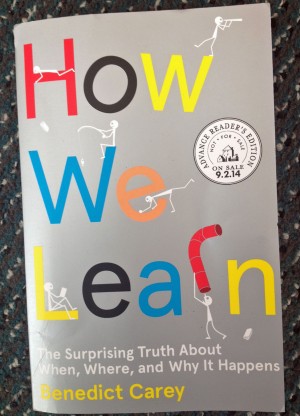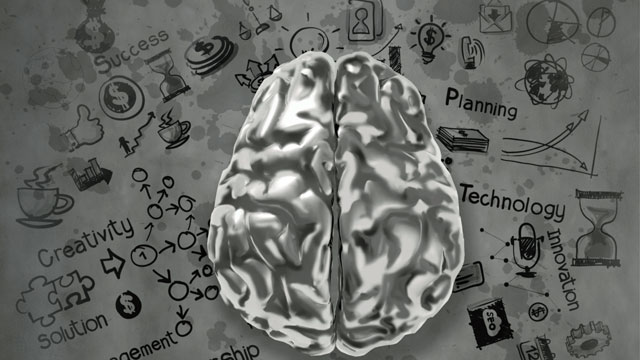Getting to Know Your Brain's Memory Processes
In an interview, he highlighted three take-home messages from his book:
Forgetting isn't always bad. Most of the time, it’s natural and essential to remembering and learning. According to a theory championed by Robert Bjork and Elizabeth Ligon Bjork at UCLA, forgetting serves as a powerful spam filter: Whenever you're trying to recall a word or fact, your brain has to actively suppress, or forget, competing information. What’s more, the way memories tend to fade over time actually aids subsequent learning. Under a principle the Bjorks call desirable difficulty, when the brain has to work hard to retrieve a half-forgotten memory (such as when reviewing new vocabulary words you learned the day before), it re-doubles the strength of that memory.
If you sit down to study a load of material, “of course you're not going to remember most of it the next day,” Carey said. You do have to go back and build your knowledge. “But it's not that you don't remember well, or you're not a good learner. It's that forgetting is a critical part of learning.”
The brain is a foraging learner. For our ancient hominid ancestors, remembering how and where to hunt prey or find shelter was crucial to survival. The human brain evolved to pick up valuable pieces of information here and there, on the fly, all the time, and put it all together, he said. It still does that -- absorbing cues from daily life, overheard conversations, its own internal musings. It keeps things in mind that are important to you (an unfinished project, for instance) and adds to your thoughts about them by subconsciously tuning in to any relevant information you see or hear around you. By foraging in this way, the brain is “building knowledge continually, and it's not only during study or practice,” Carey said. And we’re not even completely aware of that.
We can be tactical in our schooling. The traditional advice on learning has been to “study hard,” in a quiet place and with the same routine, yet that doesn’t say much about what to specifically do. But pupils today can change the way they study to exploit the brain’s quirky learning processes, using the strategies revealed by memory and learning research. While that science is still maturing, “it's at a place now where it can give you a specific tactical plan,” Carey said. Students can tailor their preparation with techniques targeting different kinds of content or skills, and manage their schedule to optimize their time. “That's a powerful thing, because we go through our whole lives never knowing that,” he said.
 For example:
For example:
-- Breaking up and spacing out study time over days or weeks can substantially boost how much of the material students retain, and for longer, compared to lumping everything into a single, nose-to-the-grindstone session.
-- Varying the studying environment -- by hitting the books in, say, a cafe or garden rather than only hunkering down in the library, or even by listening to different background music -- can help reinforce and sharpen the memory of what you learn.
-- A 15-minute break to go for a walk or trawl on social media isn’t necessarily wasteful procrastination. Distractions and interruptions can allow for mental “incubation” and flashes of insight -- but only if you’ve been working at a problem for a while and get stuck, according to a 2009 research meta-analysis.
-- Quizzing oneself on new material, such as by reciting it aloud from memory or trying to tell a friend about it, is a far more powerful way to master information than just re-reading it, according to work by researchers including Henry Roediger III and Jeffrey Karpicke. (Roediger has co-authored his own book, "Make It Stick: The Science of Successful Learning.")
Experimenting With Learning Tactics
Anybody can try these methods to see what works best, Carey said. For instance, to prepare for a Spanish test that’s one week away, students could plan to study an hour today, an hour tomorrow -- and then self-test themselves next week right before the exam, he said. The book also explores the benefits of sleep (which improves retention and comprehension of what you learn), perceptual learning modules and mixing up different kinds of related problems or skills in practice sessions instead of repetitively rehearsing just one skill at a time.
Carey thinks the science-based learning strategies should explicitly be taught to all students early on, as part of the school curriculum. But kids shouldn't use them “as an excuse to do nothing,” he added. The message isn’t that they can spend every second glued to their cellphones and still be learning. “You have to be motivated and pay attention and so on.”
Unfortunately, most people, educators included, are unaware of the lessons from the science of learning, Carey said. Education and cognitive science are largely separate worlds that have begun communicating only in the last decade, partly because “teachers see all sorts of reforms come and go, and they’re skeptical -- and rightly so -- of anyone who comes in and says, "Well, I'm going to tell you how to make the kids learn better,” he said. But some individual teachers who have followed the research may be applying certain strategies in the classroom, he said, such as assigning mixed-up math problem sets.
Knowing the basics of how the brain actually learns can offer breathing room from societal expectations about “good” academic habits. A fidgety teenager who has trouble concentrating and forgets her physics formulas might think, “I’m no good at this” or “I’m not so smart, and maybe it’s not worthwhile for me to pursue this,” Carey said. But that’s not necessarily true, according to the cognitive research. Students need to understand that learning happens not only during reading and studying, but in all sorts of ways, so that they can examine their own habits to know which ones may be helping or not, and make adjustments, he said. Only then can they evaluate whether they’re good at something.
Surviving the Modern Jungle
Ultimately, the value of these learning strategies isn’t just about earning better grades, Carey said. In the modern jungle of society, learning is still about surviving: For young people, it’s about sussing out what they’re good at, what rings their bell, and what they want to do with their lives. “It's informing you of: Who am I? Where do I place my bets? Do I major in physics or do I major in architecture or design, or do I major in English? Do I belong here at all?” Carey said. Those are important decisions. “Being self-aware about what’s effective learning and how it happens, I think, gives you a real edge in making those choices.”
Carey has fully incorporated the learning techniques into his own life -- whether in practicing guitar or getting up to speed on the latest neuroscience research to write a newspaper story. For example, when reading a difficult scientific journal article, “I realize I'm not going to understand a bunch of the stuff right away, no matter how hard I try or concentrate. I don't let that slow me down.” He runs through it a few times, puts it aside and, spacing out his learning, tries again later, when the material almost always begins to gel.
Deadline pressure often forces him to start writing his article before he even has all the pieces, which is an “extremely valuable way to efficiently pick up the knowledge,” he said. “In effect, you’re testing yourself on how much you know... and you're trying to write it clearly so you're sort of teaching it, too. Those are two very effective study techniques.”



